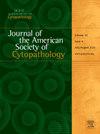Reliability of cytopathology and ancillary testing modalities in the diagnosis of extramedullary hematopoiesis and sclerosing extramedullary hematopoietic tumor: a 10-year institutional experience
Q2 Medicine
Journal of the American Society of Cytopathology
Pub Date : 2025-03-09
DOI:10.1016/j.jasc.2025.02.001
引用次数: 0
Abstract
Introduction
Extramedullary hematopoiesis (EMH) is proliferation of hematopoietic elements outside of bone marrow that's commonly associated with hematologic diseases. While sclerosing EMH (SEMHT) has overlapping clinical features with EMH, it is less cellular and has solid appearance with fibrosis and atypical megakaryocytes. EMH/SEMHT are uncommon manifestations rarely reported in cytology. This study aims to investigate the reliability and utility of cytology in diagnosis of EMH/SEMHT in cytology samples at our institution.
Materials and methods
The laboratory information system was queried over a 10-year period (2014-2024) to identify all cytology cases diagnosed on fluid cytology, fine-needle aspiration (FNA), and/or small-core biopsy with Touch preparations as EMH and/or SEMHT. History of hematopoietic disorders, specimen location, type, diagnosis, ancillary studies, and follow-up data were reviewed and correlated.
Results
A total of 11 cases from 11 patients were identified. Age ranged from 57 to 84 years, and the male:female ratio was 0.8:1. History of transplant was noted in 3 patients, and hematopoietic disorders (1-myelodysplastic syndrome, 3-primary myelofibrosis, 1-chronic myeloid leukemia, 1-essential thrombocytosis) in 6 patients. Specimen origins were distributed as:1 peritoneal fluid, 2 pleural fluids, 8 soft tissue (4-paraspinal, 1-presacral, 1-peritoneal, 1-perigastric, 1-periportal lymph-node). This corresponded to 3 fluid cytology, 5 FNAs, and 3 core biopsies/Touch preparation. Five cases were diagnosed as atypical compatible with EMH, and 6 cases were diagnosed as negative for malignant cells with trilineage hematopoiesis compatible with EMH (5) and SEMHT (1). Flow cytometry was performed on 5 cases, while immunohistochemistry was performed on 6 cases, with both ancillary studies confirming the diagnosis of EHM/SEMHT in 9 of 11 cases (82%).
Conclusions
Cytology can provide reliable and accurate method for diagnosing EMH/SEMHT. EMH is less commonly encountered in effusions (27.3%). Ancillary studies, including flow cytometry and immunohistochemistry, are reliable techniques that aid in diagnosis EMH/SEMHT in various cytology samples.
在髓外造血和硬化性髓外造血肿瘤诊断中的细胞病理学和辅助检测方式的可靠性:一个10年的机构经验。
髓外造血(EMH)是骨髓外造血因子的增殖,通常与血液系统疾病有关。虽然硬化性EMH (SEMHT)与EMH具有重叠的临床特征,但其细胞较少,具有纤维化和非典型巨核细胞的实性外观。EMH/SEMHT是细胞学上少见的表现。本研究旨在探讨细胞学诊断EMH/SEMHT在本院细胞学样本中的可靠性和实用性。材料和方法:对实验室信息系统进行了10年(2014-2024年)的查询,以确定所有通过液体细胞学、细针穿刺(FNA)和/或小核活检诊断的细胞学病例,并将Touch制剂作为EMH和/或SEMHT。对造血系统疾病的病史、标本位置、类型、诊断、辅助研究和随访资料进行回顾和关联。结果:11例患者共鉴定出11例。年龄57 ~ 84岁,男女比例为0.8:1。3例有移植史,6例有造血功能障碍(1-骨髓增生异常综合征、3-原发性骨髓纤维化、1-慢性骨髓性白血病、1-原发性血小板增多症)。标本来源分布为:1个腹膜液,2个胸膜液,8个软组织(4个椎旁,1个骶前,1个腹膜,1个胃周,1个门静脉周围淋巴结)。这与3例液体细胞学检查、5例fna检查和3例核心活检/Touch准备相对应。5例诊断为不典型与EMH相容,6例诊断为恶性细胞阴性,三期造血与EMH相容(5例)和SEMHT相容(1例)。流式细胞术5例,免疫组织化学6例,11例中9例(82%)辅助研究均确诊为EHM/SEMHT。结论:细胞学检查可为EMH/SEMHT的诊断提供可靠、准确的方法。EMH在积液中较少见(27.3%)。辅助研究,包括流式细胞术和免疫组织化学,是可靠的技术,有助于诊断EMH/SEMHT在各种细胞学样本。
本文章由计算机程序翻译,如有差异,请以英文原文为准。
求助全文
约1分钟内获得全文
求助全文
来源期刊

Journal of the American Society of Cytopathology
Medicine-Pathology and Forensic Medicine
CiteScore
4.30
自引率
0.00%
发文量
226
审稿时长
40 days
 求助内容:
求助内容: 应助结果提醒方式:
应助结果提醒方式:


